In all the history of our Yorkshire born ancestors only two have chosen to leave “God’s Own County”. The first was Isabella Dean who crossed the border into Lancashire, had an illegitimate daughter Elizabeth (Nana’s great grandmother), married and then promptly crossed back into Yorkshire. The second was Robert Walker.
I thought of him as being a bit of a rogue. Three wives is, well, either careless or greedy. And honestly who would want to leave Yorkshire for the environs of London? (Says the woman whose postcode starts NW1).
If anything, it was Robert’s wife, Elizabeth Hornby, who had left the mark on our family as at least three grandchildren and two great grandchildren were given her maiden name as their first: Ellen Hornby Parker (b. 1882), Hornby Wellock (b. 1888), Hornby Walker (b. 1892), Hornby Moor (b. 1899) and lastly Hornby Wellock born in Canada in 1905.
Yet settling down to review the documentary evidence, I was presented with a very different story. For Robert was a man (& a boy) who’s life was beset by tragedy and emigration yet time and again he picked himself up and carried on.
So, who were Robert Walker & Elizabeth Hornby?
Robert was born in Hebden in 1823, the fifth of ten children of Anne Pratt (1793 – 1855) & Thomas Walker (1793 – 1835), nine of whom were boys and, all of whom (bar the twins, Thomas & Elizabeth born in 1826) survived infancy. Thomas & his growing brood must have felt confident. They were descended (through Thomas’s mother) from the Hebdens, Bollands & Inmans, families who had run liveable farming tenancies in the area for centuries and with an expanding free workforce, his main worry was most likely that of securing decent tenancies for his sons when they came of age. Indeed the Walker brothers had all been schooled in an age when schooling was a sign of relative affluence in the village.
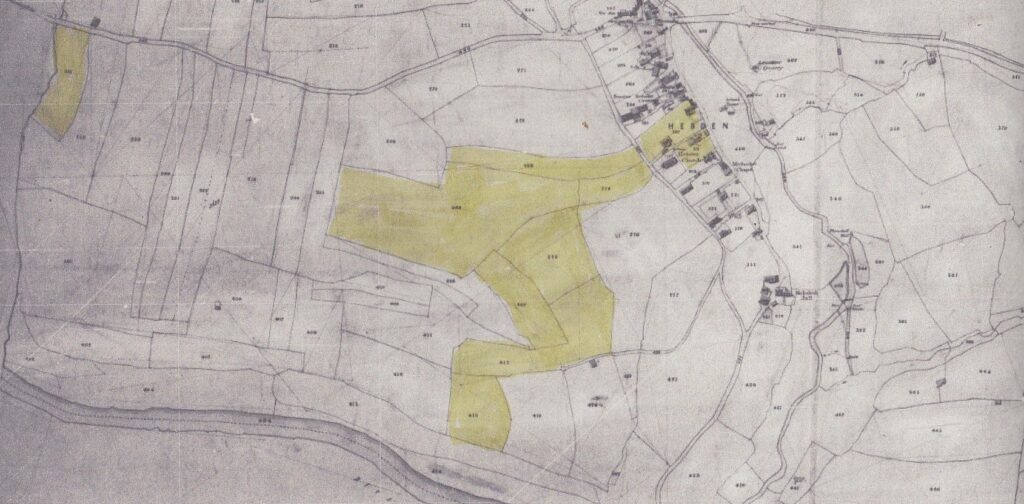
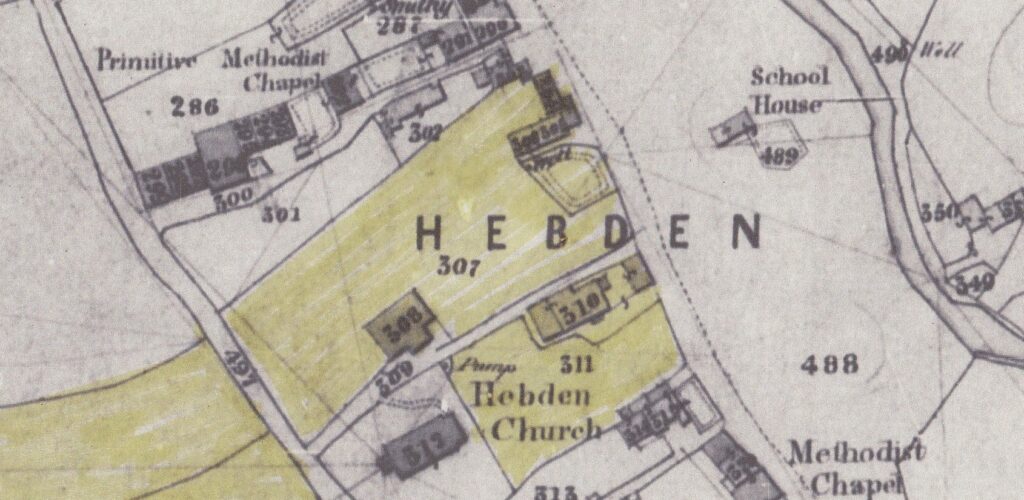
A note to help with the rest of the article, the ten Walker siblings were: John (1815 – 1868), James (1817 – 1848), Richard (1820 – 1843), William (1822 – 1863), Robert (1823 – 1873), Thomas (1826 – 1826?), Elizabeth (1826 – 1830), Thomas (1829 – 1842), Edward (1831 – aft. 1910) and Joseph (1835 – 1927).

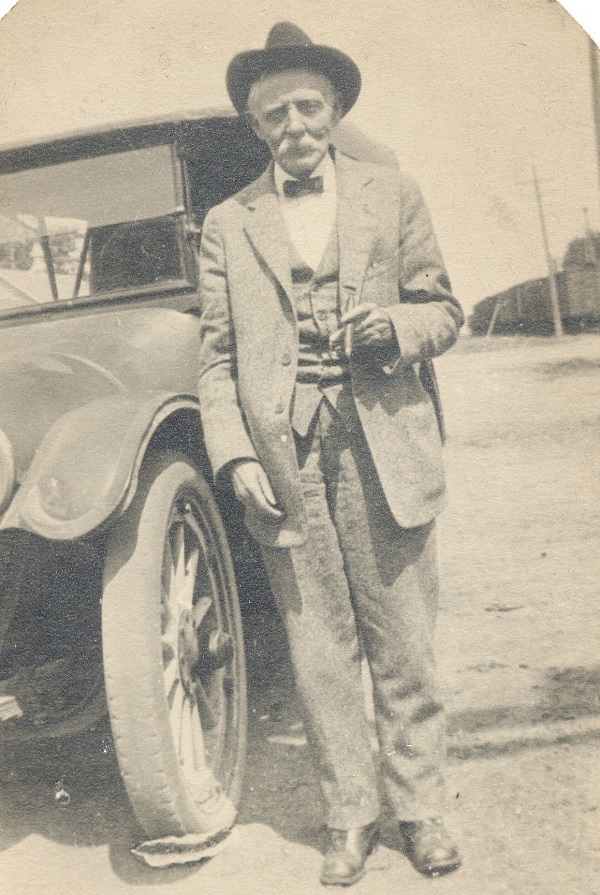
Photo courtesy of Tim Hall.
Then on 6 December 1835 life changed.
At the comparatively young age of 42 and just three days after the birth of his youngest son Joseph, Robert’s father, Thomas Walker, died. Frustratingly it was just before all the best records kick in, so I have no way of knowing what happened although B. J Harker provides a potential clue in his book Rambles in Upper Wharfedale “Previous to the year 1862, Hebden was very subject to typhus fever, and other epidemic diseases, through want of drainage and a proper supply of water”. This was to become a theme for the Walker family.
Life for the twelve-year-old Robert & his brothers would never be the same.
John (Robert’s eldest brother) took the opportunity to emigrate to the US leaving eighteen-year-old brother James to head up the household, together with his mother Anne (at least until 1840 when she took the only truly sensible option for a middle-aged widow at the time and married local widower, William Waddilove).
By 1841, two of the boys, Richard & Robert, had left the family farm. Richard was probably the “17-year-old” manual labourer working for the Pettys in Scosthrop, Kirkby Malham. Of Robert we can be more certain as he went to work for his maternal grandfather, James Pratt, at West Side House, Malham Moor. James ran a farm of 290 acres with two of his sons, James & William, William’s new wife, Margery Hornby, and a female servant Elizabeth Simpson (possibly also a relative). Robert would have known he had no chance of inheriting the tenancy, but for a fatherless sixteen-year-old this was a much better deal than his brother’s.
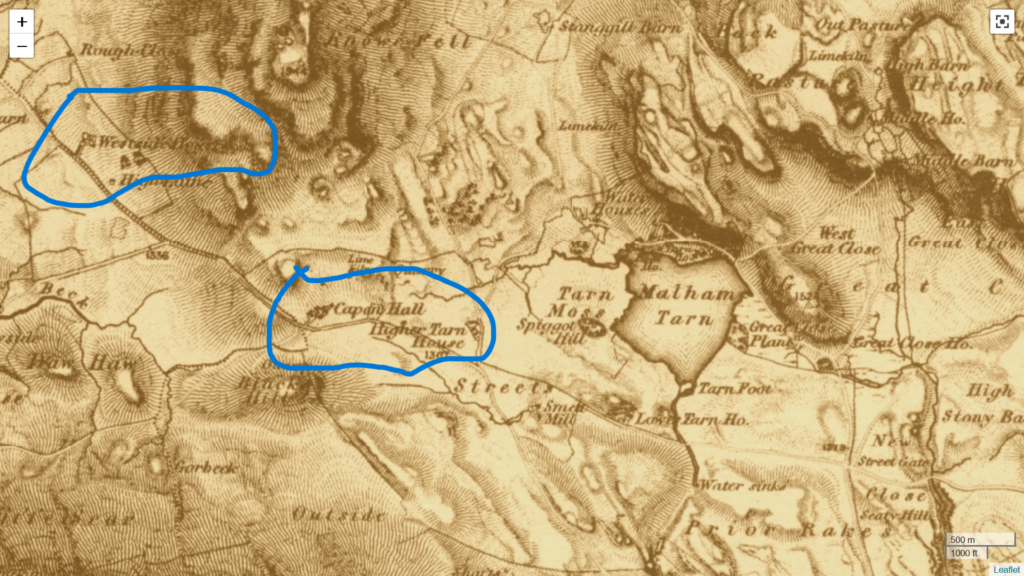
Malham is a beautiful place – the tarn & the cove attract thousands of visitors (including my sister last year). But the moor? It’s a remote place. A sprinking of stone farmhouses can be found hunkered down in slight hollows in an attempt to escape the worst of the weather. No chance of meeting a match. Unless of course your uncle’s new wife had a younger sister, Elizabeth, living a mile down the road at Capon Hall. And if Elizabeth & Margery had only one sibling, a sister, Ellen, there had to be a shot at inheriting that tenancy? (see my sister is also my aunt)
So it was that on 23 December 1844, Elizabeth Hornby & Robert Walker were married at St Michael the Archangel, Kirkby Malham witnessed by Elizabeth’s older sister Ellen & Robert’s cousin John.
As Robert moved in with his wife & her family it’s time to talk about Elizabeth. Elizabeth was the youngest of the three daughters of Mary Coates & John Hornby. John had been born in Giggleswick & Mary in Gisburn and they’d moved to Capon Hall at some point between the birth of their first daughter, Ellen, in 1816 and their second daughter, Margery, in 1819. The Capon Hall tenancy was about 200 acres of desolate moorland. Glorious when the sun was shining, harsh when the wind and snow blew through in winter.

The first two of Robert & Elizabeth’s children were born at Capon Hall: Mary (my great, great grandmother) in 1845 and Thomas in 1847.

Their third child, John, born in 1849, was baptised back in Hebden.
So, what had happened? Well, the 1840s hadn’t been good to the Walker brothers. Thomas had died first, of measles, aged 13 in 1842. Richard died the following year, aged 23, this time the cause of death was consumption. When this same highly infectious disease killed James on 5 July 1848, a vacancy for head of Walker household appeared. Would it be 27-year-old William or 24-year-old Robert who took up the role?
Had William & his new wife had already booked the transatlantic tickets that would deposit them in New York on 6 November 1848? Where they seduced by tales of gold from their older brother John or scared away from Hebden by the infectious diseases which seemed to plague the family? Or had the two remaining older brothers sat down and amicably discussed the decision between them? I certainly hope it wasn’t a hostile takeover by Robert forcing William’s emigration.
These movements also paved the way for a much more joyous occasion – the marriage of Elizabeth’s eldest sister, Ellen, to the younger James Howarth. I can’t be sure if this was before or after the girls’ father, John Hornby, died on 12 March 1850 but no doubt both father and husband had the future of the Capon Hall tenancy in mind.
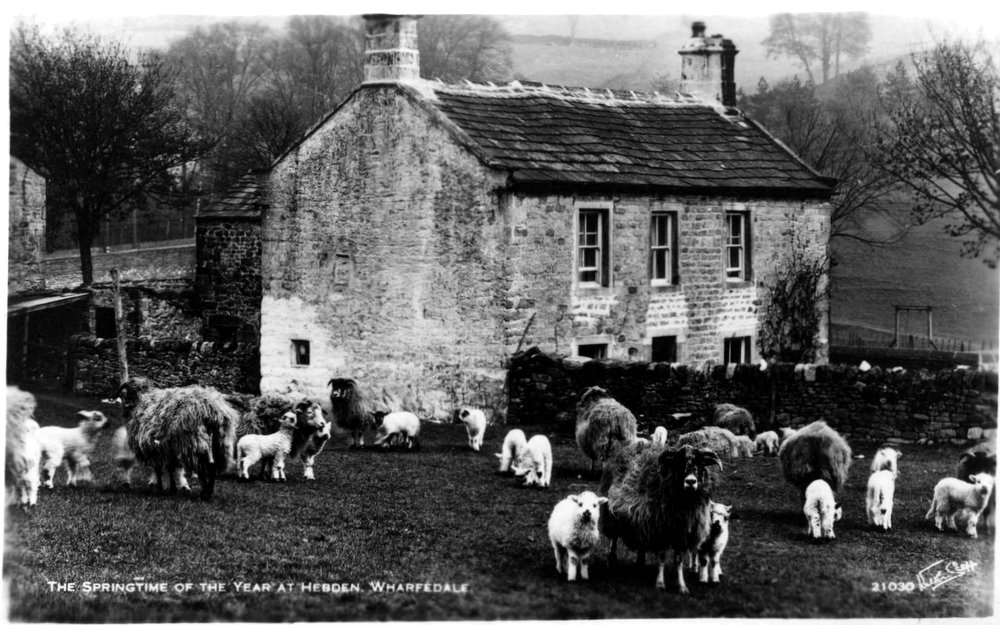
By 1851, Robert & Elizabeth were established in Hebden. Robert farmed 60 acres and worked as a butter factor too. Three more children, James (b. 1852), Ann (b. 1853) and Elizabeth (b. 1856) followed. The growing family was surely the prompt for the two remaining Walker brothers, Edward & Joseph, to follow John & William across the Atlantic leaving Robert the sole remaining Walker brother in Hebden.
All was going well until June 1858 when the couple’s seventh baby, named Robert for his father, was born. Peritonitis, an inflammation of the abdomen, is commonly caused by a hole in the bowel or a burst appendix. It is more rarely a complication of childbirth but the quick succession of birth and the onset of the condition which was to cause Elizabeth’s death two weeks later would suggest these were connected. She is buried, without a marker, in St Wilfred’s church in nearby Burnsall. Baby Robert was to follow just nine months later spending just the same amount of time inside Elizabeth’s womb as out of it. I hope he lies by his mother’s side.
What was a successful man in his thirties with seven children going to do? Well marry of course!
Hannah Fawcett Whitaker was twenty-nine, illegitimate, living between relatives, with no apparent occupation. Love at first sight or a practical solution for both? Robert & Hannah married on 15 November 1859 at St Michael’s and All Angels and Linton, fifteen months after Elizabeth died. Baby Edward arrived around a year later. By 1861, the family should have been prospering, Robert having doubled the size of his farm to 116 acres. He was, or was about to become, church warden for St Peter’s handily located just a couple of minutes from the farm and was respected enough to be asked to judge the butter classes in local agricultural shows.
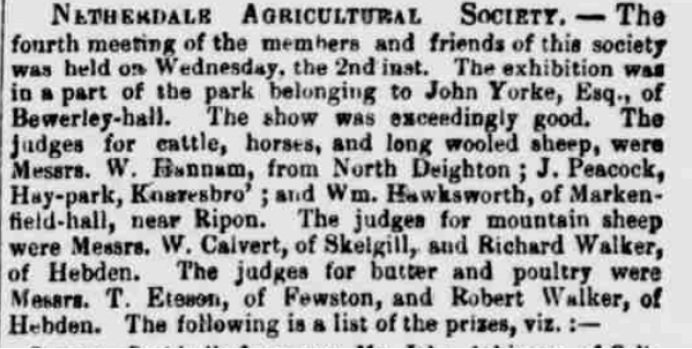
But early death seemed to stalk the Walkers of Hebden. Robert’s daughter, Ann, died from diphtheria, aged just eight on 2 October 1861 and his son Thomas, who had reached the age (fourteen) at which he might almost be considered a man, followed just two months later. Then the birth of a son on 23 January 1863 almost immediately caused Hannah’s death from a uterine haemorrhage and nor did the second baby Robert survive beyond the night.
If all that wasn’t enough, Robert, in his capacity as churchwarden, was taken to court in November of the same year in a “case of unusual character, being the first that has even been tried by this [Sheriff’s County] court” (Yorkshire Gazette, 21 November 1863). The moorland enclosures in Hebden in 1857 had been contentious as had been the distribution of various charitable funds for the poor. So much so, that the charity commission had stepped in to change those who were entitled to their receipt.
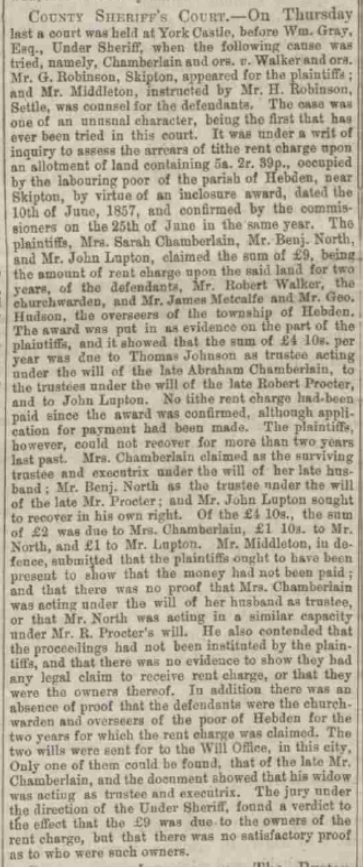
I believe it was at this point Robert felt Hebden just didn’t want him. He’d buried two wives and four children three siblings in less than six years. His remaining brothers had all emigrated and now village politics seemed to be against him so in 1864 Robert left Hebden for good.
What else to do but hotfoot it down to Hampshire? I really couldn’t believe this marriage – Walker is too common a name – but the later evidence fully stacks up. On 16 June 1868, when Robert is apparently living in Long Ditton, Surrey, he married one Harriett Jones at Ellisfield church on 16 June 1868. (Yup, Walker marries a Jones….)
By 1871 they were living on Wellington Road, Heston, somewhere between Flowerpot Cottage and Berkhams farm & dairy. I am guessing that latter address had more to do with the location as Robert was either a Coisman or Cowman and grocer during this period. That butter factoring knowledge is proved useful (although what exactly butter factoring and butter classes are will have to wait as I have a whole blog on butter to write).
Robert seems to have had little if any contact with any of his surviving children. His youngest child, Edward, had died in 1866 at the Anchor Inn, home of his great aunt Sarah and he doesn’t appear in any of the family records I have inherited. Indeed his grandson, Benjamin Wellock, brother to my great grandmother, who as the last surviving family member wrote some family history down in 1960, remembered only that his grandfather’s name was James…..
Living down South wass evidently not any better for his health than Hebden and he died, aged 49, on 22 April 1873 of typhus, the disease he perhaps fled to escape and was buried at St Leonard’s church in Heston. Our one and only ancestor buried in London. It would take me just over an hour (and five changes) to get there. It takes me two hours on one train to get back to Yorkshire.
Was he Rogue Robert? Maybe. But in the mid-1800s men had the pick of wives and maybe he was forced to be responsible, to take over the farm after his father died and his elder brothers died or emigrated. Hebden was undoubtably fractious in the early 1860s and it had not been happy place for the Walkers. Robert has left me wanting to find out more, especially in relation to the last decade of his life. Perhaps this blog is just the start of reinstating Robert back into his rightful place in our family history.

I could not have written this blog without the wealth of wonderful resources at https://hebdenhistory.uk/ invaluable to those of with ancestors from the village. Thanks to must go to https://curiousdescendants.co.uk/ who provide endless encouragement and guidance to “storify” these bios. Finally I must beg forgiveness of Rogue Robert, our one ancestor who moved out of Yorkshire and whom I underestimated for so long.
